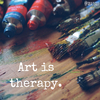Svavar Gudnason and Bram Bogart at the Cobra Museum
AMSTERDAM -- Two fascinating exhibitions are currently running side by side at the Cobra Museum in Amsterdam until January 2013. These exhibitions look at the work of the Dutch-Belgian artist Bram Bogart (as seen in photo 1) and the Icelandic artist Svavar Gudnason (as seen in photos 2 and 3).
The Cobra Museum’s permanent collection is dedicated to art from the Cobra Movement and includes paintings by Karel Appel, Corneille and Constat. Svavar Gudnason was one of the founders of the Cobra movement which helped to resuscitate an interest Dutch art
Svavar Gudnason (as seen in photo 4) was one of the most important progressive artists within the Cobra group. The name of this movement was taken from the initials of the cities where some of the founding members lived, Co for Copenhagen, Br for Brussels, and A for Amsterdam. This movement was inextricably linked with major European cities including Paris where the artists lived, met in cafés, and shared work space as well as ideas.
It was an intense post war movement which lasted three years from 1948 to 1951. Members of this movement rejected Surrealism, stating that Surrealism was too much about style and discussion whereas the Cobra movement was about action, as well as freedom of color and form. It was an optimistic movement that honoured spontaneity. Inspiration was taken from children’s drawings, and primitive art, as well as folk art and Nordic mythology. Artists such as Joan Miro also provided inspiration for this group.
One of the founding members of the Cobra Movement, Corneille, summed it up when he stated, ‘I am a painter of joy.’
Although the movement was shorted lived, in three years it produced two major international exhibitions, as well as ten copies of the Cobra movement magazine. It was disbanded in 1951, when the members stated that their aims had been achieved! Thereafter, they returned to their individual artistic paths.
Through his paintings, Svavar Gudnason is said to have introduced abstract art to Iceland. In the current exhibition, the Cobra Museum shows more than 50 paintings by this artist. These paintings show his artistic development from his early figurative landscapes to his colorful, geometric works. Those who admire his work do so as he was able to translate the mysterious Icelandic landscape into a universal language. He poignantly interpreted the unique nature of Iceland. He felt a close soul connection to a number of Danish experimental painters and other founding members of the Cobra group such as Carl- Henning Pedersen and his wife Else Alfelt.
The Dutch-Belgian artist Bram Bogart was linked with the Cobra movement as he shared working space in Paris for a number of years at the famous warehouse in Rue Santeil where the Cobra artists Karen Appel and Corneille also had their studios. However he was not a member of this movement but rather concentrated on developing his own innovative method of painting which became known as matter painting and art informel. He directly applied unmixed paints to his canvases and sought his inspiration in other materials that were also applied such as cement mixtures. The way he worked gave his ‘paintings,’ a third dimensional, and sculptural quality. His work allowed color and materials such as cement to be welded together. The retrospective of his work at the Cobra Museum includes over seventy paintings from 1939 until 2009, with a particular emphasis on his artistic creation in the 1950s. He summed up his own work simply, stating, ‘I am a painter, an expressionist painter.’
These two exhibitions enable us to share in the artistic development of two great artists, through the artistic movements that they helped to create, the Cobra Movement and Matter Painting. They also serve as a just reminder that painters from Nordic countries played an essential role in the artistic movements of the twentieth century.
Photos 1: Courtesy of the Cobra Museum, Amsterdam
Photo 2: Courtesy of the Cobra Musuem, Amsterdam and the Asi Art Museum, Reykavik
Photo 3 : Courtesy of Asi Art Museum, Reykjavik
Photo 4: Courtesy of the Asi Art Museum, Reykavik











